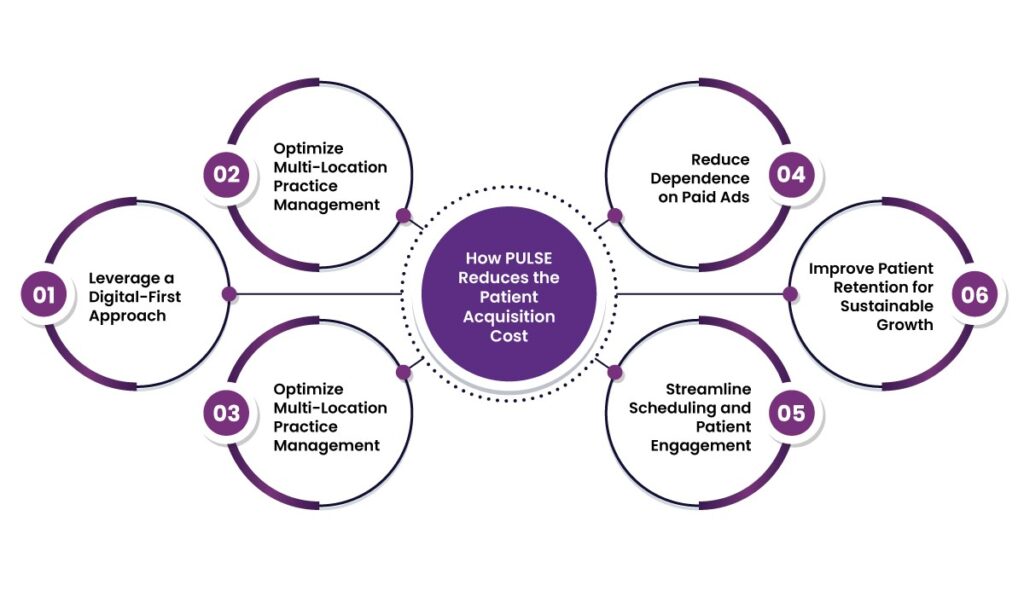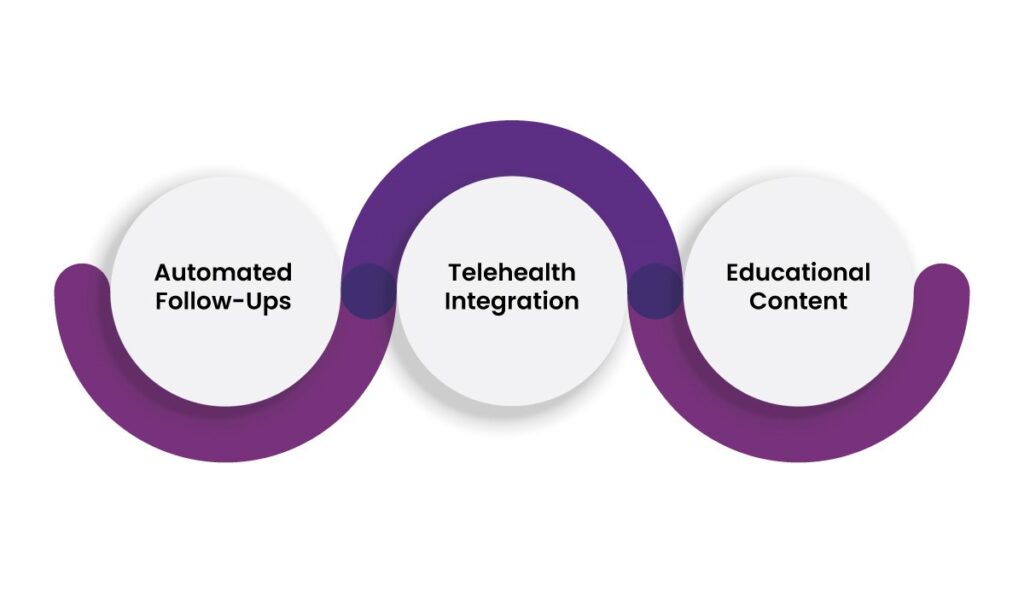Today, bringing new patients into a healthcare center is no small task. For years, providers have relied on traditional methods like word-of-mouth referrals, print advertising, and even costly digital ad campaigns to fill their appointment slots. While these tactics work, they often come with high expenses and inconsistent results. Therefore, the challenge isn’t just about finding new patients—it’s about doing so in a way that keeps costs manageable while maintaining a steady flow of appointments.
This is where PULSE empowers healthcare providers with a long-term, sustainable strategy for patient acquisition. By optimizing their online presence, PULSE helps providers attract and engage patients organically— thus reducing the need for high-cost ads while improving visibility where it matters most. In this blog, let’s discuss how PULSE lowers your patient acquisition costs.
Patient Acquisition Cost (PAC): Definition & Importance
Before exploring PULSE, let’s establish a common understanding of PAC. Patient Acquisition Cost (PAC) is the total cost incurred by a healthcare provider, hospital, or clinic to acquire a new patient. This metric helps healthcare organizations measure the efficiency of their marketing and outreach efforts. For example, if a dental clinic spends $10,000 on marketing and gains 500 new patients, the PAC would be:
10,000/500 = 20
So, the Patient Acquisition Cost is $20 per patient.
Table of Contents
How PULSE Reduces the Patient Acquisition Cost
Here’s how PULSE helps healthcare providers reduce patient acquisition costs:
1. Leverage a Digital-First Approach
In this digital age, patients rely on the internet to find and choose healthcare providers. Therefore, establishing a strong online presence eliminates the need for costly traditional marketing efforts like print ads and billboards. With PULSE, providers can create an online identity using a structured approach.
How Providers Can Establish an Online Presence with PULSE
- Identity Verification: Providers can securely validate their credentials to register on PULSE.
- Create a Health Center Profile: Providers can add their health centers by adding relevant details, such as:
- Group NPI
- Health Center Name & Type
- Specialization
- Electronic Medical Records (EMR) Integration
- Contact Information (Email, Work Phone, Fax, etc.)
This digital profile makes it easier for potential patients to find and evaluate healthcare centers before making an appointment.
2. Optimize Multi-Location Practice Management
By offering seamless multi-location management, PULSE makes it easier for patients to find and book appointments with the right provider at their preferred location. As a result, patients can effortlessly schedule appointments at the most convenient location, which can help decrease scheduling conflicts and reduce the likelihood of cancellations or no-shows.
3. Credibility Through Comprehensive Profiles
Patients are more likely to trust and book appointments with providers who display verified credentials, affiliations, and specialties. Here’s how PULSE allows providers to showcase their expertise:
Provider Information:
- NPI (National Provider Identifier): Unique identification number for healthcare providers.
- Credentials: Medical degrees, licenses, and board certifications.
- Specialization: Medical and surgical specialties (e.g., Cardiology, Orthopedics, Pediatrics).
- Affiliations: Hospitals, clinics, and other healthcare organizations where the provider practices.
Personal Information:
- Languages Spoken: Languages fluently spoken by the provider.
- Education: Medical school, residency, fellowship training, etc.
- Memberships: Professional organizations (e.g., American Medical Association).
- Certifications: Specialized certifications beyond basic medical licensure.
Contact Details:
- Phone Numbers: Office, mobile, and fax numbers.
- Email Addresses: Professional and personal email addresses (if applicable).
By showcasing expertise through a detailed profile, providers can establish credibility and convert potential patients into actual appointments without additional spending on reputation management services.
4. Reduce Dependence on Paid Ads
Many healthcare providers rely on paid advertising to acquire new patients. However, these ads come with high costs and unpredictable returns. On the contrary, a well-optimized online presence through PULSE reduces dependence on paid ads by driving organic patient engagement. Here’s how:
- Enhanced Search Engine Optimization (SEO): Since providers can boost their online visibility with PULSE, it can lead to more patient visits from search engines without relying on paid advertising.
- Targeted Patient Outreach: Patients searching for specific specializations can directly discover providers.
- Leveraging Patient Testimonials: Positive patient reviews and testimonials build trust and credibility. This encourages word-of-mouth referrals and organic patient growth.
5. Streamline Scheduling and Patient Engagement
Inefficient scheduling is a hidden patient acquisition cost that often goes unnoticed. That’s why manual appointment booking often results in no-shows, scheduling conflicts, and administrative inefficiencies, all of which impact operational efficiency and revenue.
PULSE eliminates these challenges with an intelligent scheduling system, which gives providers full control over their availability. By automating appointment management, it reduces administrative burdens, minimizes scheduling conflicts, and enhances patient engagement—leading to a smoother, more efficient workflow.
6. Improve Patient Retention for Sustainable Growth
Acquiring new patients can be expensive and time-consuming, but keeping existing patients engaged is a much smarter investment. PULSE strengthens these long-term relationships by providing seamless communication, timely follow-ups, and a personalized patient experience.

How PULSE Strengthens Patient Loyalty
- Automated Follow-Ups: With automated reminders, patients receive timely alerts about upcoming visits, post-care instructions, and even check-ins for chronic condition management.
- Telehealth Integration: By integrating virtual consultations, PULSE makes healthcare more accessible for patients. Therefore, patients can seek medical advice without the hassle of in-person visits.
- Educational Content: Providers can share valuable health tips and wellness resources through PULSE.
Final Thoughts
Reducing patient acquisition costs is crucial for healthcare providers looking to expand their reach without overspending. By leveraging PULSE, providers can create a compelling online presence, optimize practice management, and streamline patient engagement—all of which contribute to cost-efficient patient acquisition.
Instead of relying on traditional advertising and manual appointment scheduling, healthcare providers can embrace PULSE to attract and retain patients more effectively. This approach not only cuts down on marketing expenses but also enhances patient experience.
If you’re ready to transform your patient engagement strategy, discover how PULSE can help you find more patients and grow your practice effortlessly. Contact us today and get a free consultation!

FAQs
1. What is patient acquisition cost, and why does it matter?
Patient acquisition cost (PAC) is the total expense of attracting and converting a new patient. Keeping PAC manageable allows healthcare providers to grow sustainably while maintaining profitability.
2. How can healthcare providers lower their patient acquisition costs?
Providers can reduce PAC by leveraging digital strategies like search engine optimization (SEO), automated scheduling, and patient engagement tools. Platforms like PULSE help improve online visibility and streamline operations, which cuts down the need for expensive advertising.
3. Why is organic patient acquisition more cost-effective than paid advertising?
Paid advertising can be expensive and yield inconsistent results. In contrast, organic patient acquisition—achieved through strong online presence, patient referrals, and informative content—provides long-term benefits without recurring ad spend.
4. How does an optimized online presence reduce patient acquisition costs?
A well-maintained digital profile, featuring provider credentials, services, and reviews, helps patients find and trust healthcare professionals without relying on costly lead-generation services or paid promotions.
5. Can patient testimonials and online reviews impact patient acquisition costs?
Absolutely! Positive testimonials and reviews increase credibility and attract new patients organically. PULSE makes it easy for providers to collect and showcase patient feedback.
6. What role does patient retention play in reducing acquisition costs?
Retaining existing patients is significantly more cost-effective than acquiring new ones. Automated follow-ups, telehealth services, and personalized patient engagement strategies keep patients loyal and reduce the need for continuous new acquisitions.
7. How can telehealth services contribute to lowering patient acquisition costs?
Telehealth reduces overhead costs associated with in-person visits while expanding the provider’s reach to more patients. It offers convenience, which leads to better engagement and fewer lost appointments.














